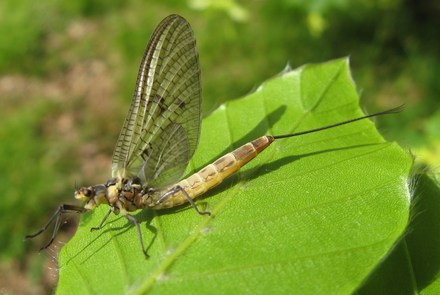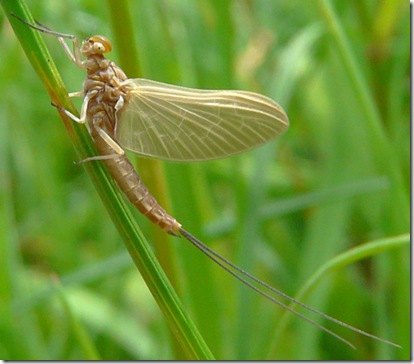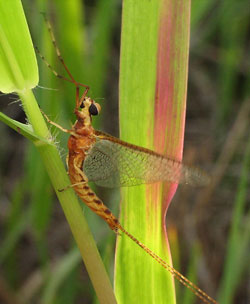
Nutr ition
ition
Mayflies are herbivores that eat numerous forms of plants including algae, rooted aquatic vegetation, and plant debris. They have a crucial role in ecosystems based on their food choice and life cycle. After the mayflies hatch there is always some form of plant debris around so transportation to food is not a major problem for this organism.
Digestion
Mayflies have a straight through digestive system divided
into three sections, the stomodaeum, the mesenteron, and the
proctodaeum (Traver, 1972). The stomodaeum is formed as an
invagination of the ectoderm and consists of the buccal cavit y,
the pharynx, and the esophagus. The mesenteron, or
mid-intestine is the longest portion of the digestive tract and
it extends from the anterior stodaeum to the posterior
proctodaeum. The proctodaum extends from the mesenteron to
the posterior opening of the mayfly also known as the anus.
Histology of the mesenteron consists of an interior lining of
columnar epithelium surrounded by a layer of circular muscle
which itself is covered with longitudinal muscle fibers (Traver,
1972). The epithelial lining serves as a means of nutrient
uptake from digested materials traveling through the intestine, and
the muscular layers help move food along the digestive tract via
peristaltic movements.
y,
the pharynx, and the esophagus. The mesenteron, or
mid-intestine is the longest portion of the digestive tract and
it extends from the anterior stodaeum to the posterior
proctodaeum. The proctodaum extends from the mesenteron to
the posterior opening of the mayfly also known as the anus.
Histology of the mesenteron consists of an interior lining of
columnar epithelium surrounded by a layer of circular muscle
which itself is covered with longitudinal muscle fibers (Traver,
1972). The epithelial lining serves as a means of nutrient
uptake from digested materials traveling through the intestine, and
the muscular layers help move food along the digestive tract via
peristaltic movements.
Transport of Nutrients
The circulatory system for mayflies is universal across all
the species with some minor differences. It
 consists of a
single dorsal vessel that lies just below the the dorsal body
wall. The posterior portion of the dorsal vessel is the
widest section of the vessel and serves as a primitive heart
with ten chambers corresponding to the ten abdominal segments (Traver,
1972). Each chamber has slit like openings called ostia as
well as a pair of internal valves (Traver, 1972). The body
cavity is called the haemocoele and it forms a sinus along
either side of the midline that carries the blood, a lymph like
fluid, to the flies appendages including the legs.
consists of a
single dorsal vessel that lies just below the the dorsal body
wall. The posterior portion of the dorsal vessel is the
widest section of the vessel and serves as a primitive heart
with ten chambers corresponding to the ten abdominal segments (Traver,
1972). Each chamber has slit like openings called ostia as
well as a pair of internal valves (Traver, 1972). The body
cavity is called the haemocoele and it forms a sinus along
either side of the midline that carries the blood, a lymph like
fluid, to the flies appendages including the legs.
The respiratory system of the mayfly differs depending o n the
stage in the life cycle. The nymph breaths via seven pairs
of plate like gills on the sides of the abdomen. These
gills are connected to many branches of tracheal tubes that
disperse the oxygen to the rest of the body. Once the
imago stage of the life cycle is reached the entire respiratory
system of tracheal tubes open up to the environment by using ten
pairs of spiracles (Traver, 1972). The spiracles are
elongated openings with two on the thorax and eight on the
abdomen (Traver, 1972). This change in the respiratory
system reflects the diversity of life styles the mayfly
undergoes by needing to breath both under water and on land at
different stages.
n the
stage in the life cycle. The nymph breaths via seven pairs
of plate like gills on the sides of the abdomen. These
gills are connected to many branches of tracheal tubes that
disperse the oxygen to the rest of the body. Once the
imago stage of the life cycle is reached the entire respiratory
system of tracheal tubes open up to the environment by using ten
pairs of spiracles (Traver, 1972). The spiracles are
elongated openings with two on the thorax and eight on the
abdomen (Traver, 1972). This change in the respiratory
system reflects the diversity of life styles the mayfly
undergoes by needing to breath both under water and on land at
different stages.
Still want to learn more about mayflies?
Visit the
classification section to learn about mayfly phylogeny
and classification. For more general information about
mayflies, visit
entweb.clemson.edu.
Back to homepage